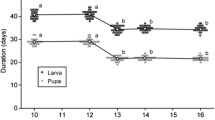Summary
We studied the influence of diet composition and breadth on the subsequent acceptability of three novel plants to sixth instarSchistocerca americana. Rearing diets of equal breadth differing in composition, and diets differing in breadth, significantly altered first meal length on some but not all of the test plants. These effects on palatability altered and at times reversed the palatability hierarchy of insects reared on different diets. The effects of rearing insects on broad diets were not produced by exposure to the plant odors alone, but apparently required contact with a diversity of plants while feeding. Switching diets for 24 h prior to testing did not alter preferences induced by rearing diets. The relationship of these patterns to induced preferences in other insects, and some possible mechanisms for generating induced preferences, are discussed.
Similar content being viewed by others
References
Bernays EA, Wege P (1987) Significance levels of inferential statistics and their interpretation: a lesson from feeding deterrent experiments. Ann Entomol Soc Am 80:9–11
Blaney WM, Schoonhoven LM, Simmonds MSJ (1986) Sensitivity variations in insect chemoreceptors; a review. Experientia 42:13–19
Boer G de, Hanson FE (1984) Foodplant selection and induction of feeding preference among host and non-host plants in larvae of the tobacco hornwormManduca sexta. Ent Exp Appl 35:177–193
Capretta PJ, Petersik JT, Stewart DJ (1975) Acceptance of novel flavours is increased after early experience of diverse tastes. Nature 254:689–691
Jaenike J (1983) Induction of host preference inDrosophila melanogaster. Oecologia 58:320–325
Jaenike J (1986) Intraspecific variation for resource use inDrosophila. Biol J Linn Soc 27:47–56
Jermy T (1987) The role of experience in the host selection of phytophagous insects. In: Chapman RF, Bernays EA, Stoffolano JG (eds) Perspectives in chemoreception and behavior. Springer, New York, pp 143–157
Laing DG, Panhuber H (1980) Olfactory sensitivity in rats reared in an odorous or deodorized environment. J Comp Physiol A 124:259–265
Lee JC (1990) Processes involved in dietary mixing by the grass-hopper {jtSchistocerca americana}. PhD thesis, Department of Entomology, University of California, Berkeley
Ma WC (1972) Dynamics of feeding responses inPieris brassicae Linn. as a function of chemosensory input: a behavioral, ultrastructural and electrophysiological study. Med Landbouwh Wagen 72:1–162
Meisami E (1986) Central and peripheral influeces on postnatal growth and development of the olfactory bulb in the rat. In: Breipohl W (ed) Ontogeny of Olfaction, Springer, Berlin pp 157–173
Mulkern GB, Pruess KP, Knutson H, Hagen AF, Campbell JB, Lambley JD (1969) Food habits and preferences of grassland grasshoppers of the morth central Great Plains. Bulletin No. 481, North Dakota State University Agricultural Experiment Station. pp 1–32
Otte D, Joern A (1977) On feeding patterns in desert grasshoppers and the evolution of specialized diets. Proc Acad Nat Sci Phil 128:89–126
Papaj DR, Prokopy RJ (1989) Ecological and evolutionary aspects of learning in phytophagous insects. Ann Rev Ent 34:315–350
Papaj DR, Opp SB, Prokopy RJ, Wong TTY (1989) Cross-induction of fruit acceptance by the medflyCeratitis capitata: The role of fruit size and chemistry. J Insect Behav 2:241–254
Schmidt U, Eckert M (1988) The influence of early odour experience on the neural response of the olfactory bulb in laboratory mice. J Comp Physiol A 163:771–776
Simpson SJ, Simpson CL (1990) The mechanisms of nutritional compensation by phytophagous insects. In Bernays EA (ed) Insect-Plant Interactions, vol. II, CRC Press, Boca Raton, Florida, USA, pp 111–160
Technau GM (1984) Fiber number in the mushroom bodies of adultDrosophila melanogaster depends on age, sex, and experience. J Neurogenet 1:113–126
Wasserman SS (1982) Gypsy moth(Lymantria dispar): Induced feeding preferences as a bioassay for phenetic similarity among host plants. In Visser JH, Minks AK (eds) Proceedings of the Fifth International Symposium on Insect-Plant Relations. Pudoc, Wageningen. pp 261–276
Wiseman BR, MacMillan WW (1980) Feeding preferences ofHeliothis zea larvae preconditioned to several host crops. J Georgia Entomol Soc 15:449–453
Author information
Authors and Affiliations
Rights and permissions
About this article
Cite this article
Howard, J.J., Bernays, E.A. Effects of experience on palatability hierarchies of novel plants in the polyphagous grasshopperSchistocerca americana . Oecologia 87, 424–428 (1991). https://doi.org/10.1007/BF00634601
Received:
Accepted:
Issue Date:
DOI: https://doi.org/10.1007/BF00634601




